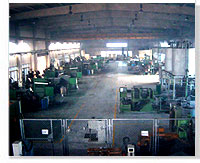Casting foundries have become an integral part of our lives. Foundries contribute heavily to the automotive, electric, petroleum and machining industries. A foundry can produce sand casts, die casts or permanent mold casts. A foundry allows the consumer to have a smooth, textured, durable and non-corrosive product.
 Die-casting products constitute more than 20% of daily household appliances. Engineers and scientists envisage that the importance of die-casting will only multiply in the future. The die-casting industry is going to grow from strength to strength owing to various technological advances. Die casting products have successfully invaded every sphere of household, commercial and industrial life. Their applications can be found in simple household appliances such as faucets to complex commercial and industrial applications in the automobile industry.
Die-casting products constitute more than 20% of daily household appliances. Engineers and scientists envisage that the importance of die-casting will only multiply in the future. The die-casting industry is going to grow from strength to strength owing to various technological advances. Die casting products have successfully invaded every sphere of household, commercial and industrial life. Their applications can be found in simple household appliances such as faucets to complex commercial and industrial applications in the automobile industry.
The two commonly used casting processes in the foundry system are as follows:
- Single cavity to produce one component
- Multiple cavity to produce a number of identical parts
- Unit die to produce different parts at one time
- Combination dies to produce several different parts for an assembly.
Die Casting Process :
It can be defined as the process of forcing molten metal under high pressure into steel molds called "dies." In other words, die-casting forms an integral part of the metalworking industry. The dies used are expensive in nature to produce non-ferrous metal parts of zinc, aluminum and copper. Dies can be structured in diverse shapes to produce implements of various textures and sizes. In a foundry, casts of molten metal are produced on a daily basis. Though expensive, the method of die casting in a foundry follows particular steps.
Melting - This is the first step in the production of a cast. It usually involves developing the charge which is later to be melted inside a furnace. The "charge" consists of scrap which is internal and external in nature. While the external scrap consists of materials which are obtained from processes such as punching, forging and machining, the internal scrap comprises of gates, risers or defective castings. The charge can also include waste material of a liquid nature or the pure forms of an alloying metal. The charge is the most important component of the melting process. The process of melting moves through certain steps: first, the charge is melted, the melt is then refined, which is followed by adjustments of the melt chemistry, and finally it is put into a transport vessel.
The molten metal is put or injected into the die under temperatures of high pressure equaling 10-210Mpa (1,450-30,500) PSI. The process can be categorized into the "Cold Chamber process" and the "Hot Chamber process."
Cold Chamber Process: In this process the molten metal is gently poured into the cold chamber for each shot. This allows for less time exposure between the cold plunger and the molten metal. The method is usually used for metal alloys of aluminum and copper.
Hot Chamber Process: The hot chamber process is mainly used for metals which boast of a low melting point and high fluidity. This includes metal alloys of tin, zinc and lead. The process entails the complete permanent immersion of the die in the molten metal. The hot pressure chamber is connected to this die. The connecting tube or inlet point of the chamber is opened briefly to enable the plunger to squeeze the molten metal into the die. Thus, the process has to be precise and quick.
Furnaces - A furnace is a vessel which is lined with some refractory substance, and it contains the material to be melted. Furnaces constitute a crucial component of a die-casting foundry and they provide energy for the melt down. Furnaces come in a range of sizes: some weigh only a few ounces while others weigh as much as hundreds of tons. They must be designed in accordance with the specifications of the metal to be melted. In addition, the furnace design must also meet the properties of the fuel which is used to generate the required high
Furnace choice is dependent on the alloy system and the quantities produced. Modern furnaces include electric arc furnaces (EAF), induction furnaces, cupolas, reverberate and crucible furnaces. Induction furnaces are usually used for ferrous materials, EAFs and cupolas. Reverberate and crucible furnaces are used for producing aluminum die-castings.
Molding - The molding process defines casting and the ultimate functioning of a die-casting foundry. The melted metal has to be poured into a mold. The mold used usually depends upon the foundry function and design including the quantity of liquid metal to be poured. It also depends upon the size and complexity of the desired casting.
Die casting is a versatile process enabling the high-speed production of complex and intricate appliances on a mass scale. The die casting foundry has simplified assembly line production enabling motor and metal industries to produce durable products.
